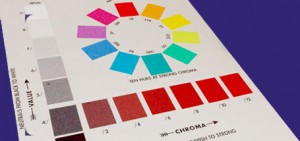
Imagine yourself back in the late 1800’s… electric light bulbs were “high tech” and Albert H. Munsell, being from the metropolitan Boston area, was unlikely to have indoor plumbing.
But what really kept Munsell awake at night was color anarchy—using poetic terms to describe color such as baby blue, lemon yellow, and many more—yet failing to effectively communicate color. In fact, Munsell references Robert Louis Stevenson, one of the greatest writers of the time, as having difficulty describing the color he wanted in his “Vailima Letters” (Circa 1890, page 94) where Stevenson refers to “A topazy yellow” and a red that is neither Turkish nor Roman nor Indian. Huh?…
The Color Wheel Chart: A Step Away From Color Anarchy
The consummate educator, Munsell was confounded by the lack of effectiveness when communicating color beyond the basic red, orange, yellow, green, etc.; especially when teaching color. That’s when Munsell went back to his artist roots to develop the Munsell color wheel or color hue circle.
Color Wheel Revolutionizes Color Communication
The hue circle was based on the artist’s concept of complementary colors with red at the 12:00 o’clock position followed by orange, yellow, green, etc., which was also based on the scientific principles of the visible spectrum. Remember 5th grade science and ROY G BIV? The Munsell color wheel uses the same order except placed in a circle, which Munsell refers to as the “hue circle.” Any three colors separated by 120 degrees in the hue circle form a complementary trio such as red, green and blue.
Taken a step further, the color wheel chart was further segmented into units where the primary colors were 10 units apart. So red and yellow were separated by 10 units and in between—at five units—was orange/yellow. Another 10 units separated yellow from green and at five units between yellow and green was green/yellow, etc. all around the color wheel. Each color was described by Munsell as a “hue family.” Now we’re talking color! But for Munsell, the color wheel wasn’t enough to adequately communicate color.
Munsell believed that, much like music has a system by which each sound is described in terms of pitch, intensity and duration; color could also be organized by three dimensions. Hue is the first dimension and a big step away from color anarchy. Remember… it’s only the late 1800’s, so this is truly remarkable work—enough to make you velocipede pop a “color wheelie.”
Learn about Munsell’s 2nd and 3rd dimensions: Munsell Color Value Scale and Munsell Color Chroma Scale.
References:
Munsell, A.H., ed. 12, 1971. A Color Notation. Baltimore, MD: Munsell Color Company.



I take watercolor classes. Our new instructor uses the Munsell Color wheel chart. He gave us a black and white printout of it but I would love a wheel with color, does one exist to purchase? Hope so! If so, let me know where and how to buy one. Thanks so much.
The Munsell Hue Circle is what you are looking for as it is closest to the color wheel chart. You can find it here: https://munsell.com/color-blog/munsell-hue-circle/
Need a color chip was given the following info.
Munsell Blue 5 pb 2/4
Hello Mark,
Please contact munsellsales@xrite.com for more information on the color chip you are looking for.
I want to expand my soil color chart book with additional pages including 5R, 10 Y, 5 BG, and 10 PB to identify standard colora on archaeological artifacts. How may I purchase such charts?
I teach a floral design class and when I had received my AIFD floral design book i was given a Munsell color chart that looks a lot like this one: https://www.amazon.com/Hal-Reeds-Analogous-Color-Wheel/dp/B004GNK8KY
Do you guys have an updated version of this?